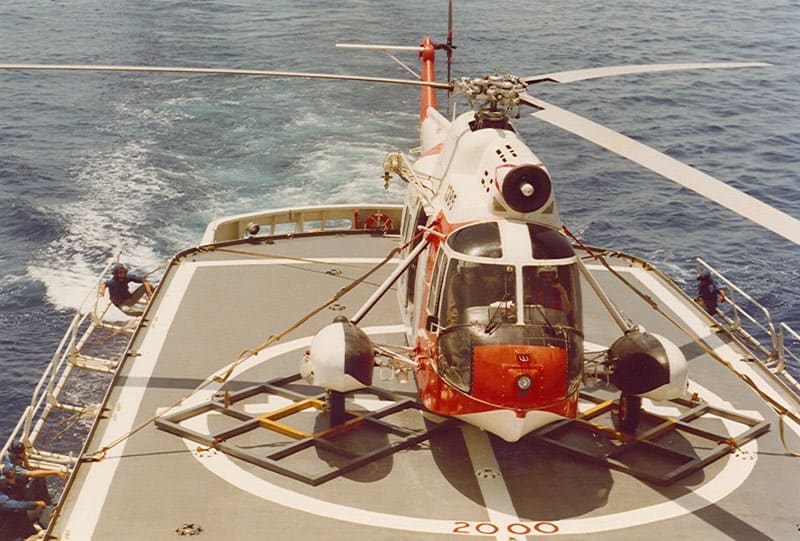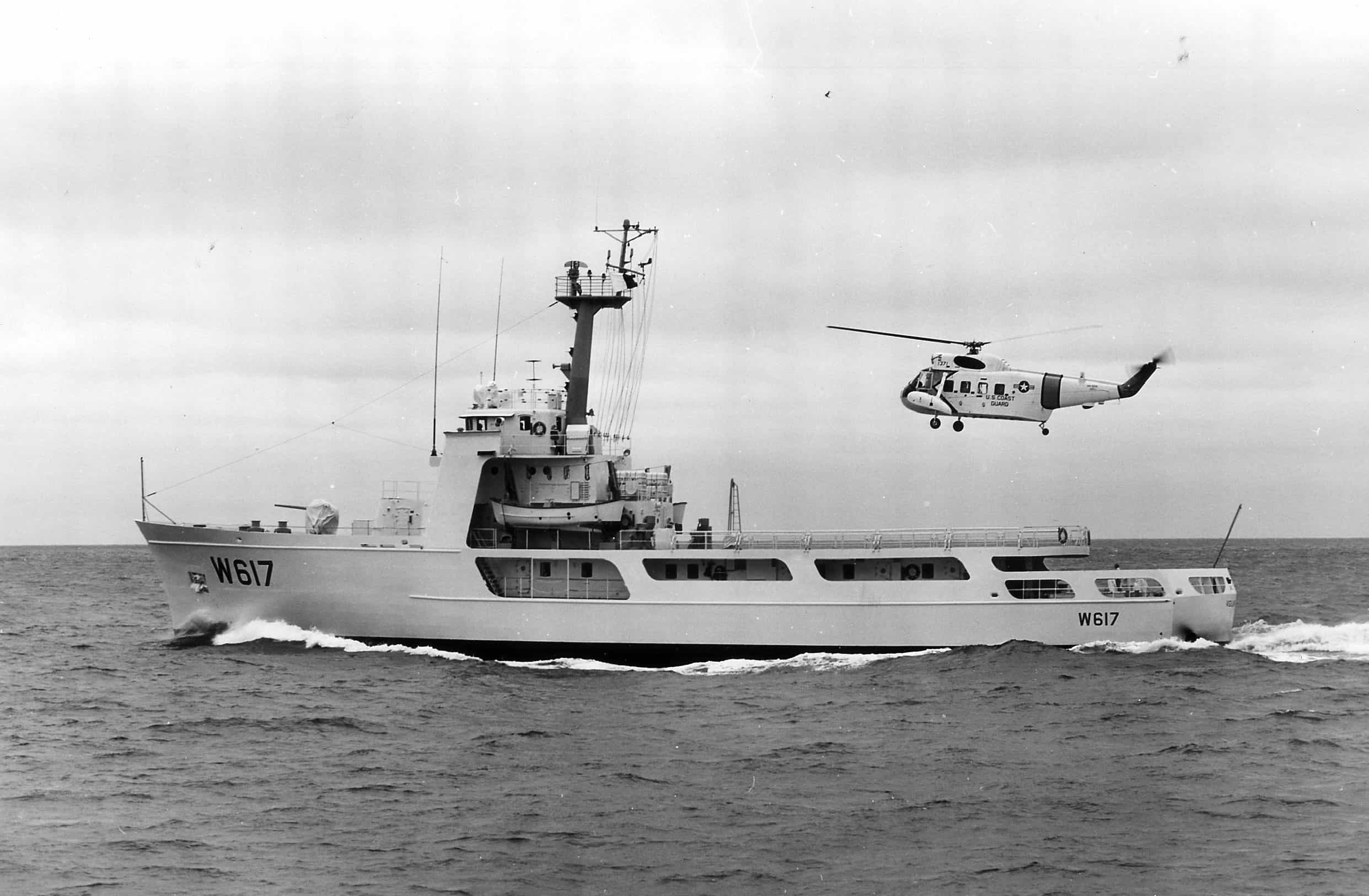They Were Designed With a Helicopter Landing Platform but No Hangar

A long range plan, suggested by the Assistant Secretary of the Treasury, to address the obsolescence of the cutter fleet was undertaken in 1959. The first cutters built under this plan were thirty six 95 foot patrol boats followed by seventy nine 82 foot patrol boats. Meanwhile the first postwar cutters were being designed to replace the 125 and 165 footers. They were the first cutters, designed from the keel up to facilitate helicopter operations. The helicopter landing platform required a minimum 200-foot waterline.
The initial concept of helicopter operations from cutters was pioneered by Frank Erickson during the Coast Guard development of the helicopter during World War II. Operation High Jump and subsequent Arctic and Antarctic operations demonstrated the value of the helicopter to the icebreaker. This concept, strongly supported by their Commanding Officers, did not carry over into the rest of the cutter fleet during this period. However, CAPT John P Latimer, a LT at the time, while attending postgraduate school after WWII, with assistance from CDR Frank Erickson and LTJG Art Pfeiffer, did a design project of a ship with a helicopter landing platform. It was about the size of the future Hamilton Class cutters with a configuration similar to the future Hamilton and Reliance Class. Latimer had consulted with Erickson and flew onto ships in a helicopter. His design provided for a helicopter deck and a hangar. Latimer said that he was surprised when he later served a tour in the Headquarters Engineering Section (ENE), that the design had received quite a bit of study by a couple of civilian architects. One of these gentlemen was Sam Frank, who was the senior civilian when the Reliance and then the Hamilton were designed. CAPT Gil Schumacher, Chief of ENE in 1962, with the assistance of CDR CG Houstma and Sam Frank, evolved and pushed through the design.
The outward appearance of these new cutters reflected the evolving nature of Coast Guard operations during the latter part of the 20th Century. They had sleek lines with the most prominent feature being the flight decks. They were originally fitted with transom exhaust ports that provided more room for a larger flight deck and kept the flight deck clear of exhaust smoke. In practice, however, the exhaust system proved problematic. Their high pilot house gave the bridge crew unrestricted all-around visibility, making ship-handling easier. A number of other concerns figured into the design phase including maximum serviceability, improved habitability, long service life, and safety. Two shafts capped by controllable pitch propellers drive these cutters to a top speed of 18 knots. The Cutters have a propulsion plant consisting of two Cooper-Bessemer Corporation FVBM-12 turbocharged diesel engines. The propulsion system can be remotely controlled from the pilot house, either bridge or wing, or the engine room control booth.
The construction of the 210 foot cutters to provide for helicopter operations was not without strong opposition on the part of some. With many it was an aversion to change but there were legitimate unknowns and problems to overcome. While the model of the vessel was given a thorough evaluation at the Taylor Model Test Basin in Washington D.C., only the characteristics as far as sea handling could be obtained. ENE was emphatic that they had no idea how the vessel would handle or reset with an 8500 pound helicopter on the flight deck. In addition, Sikorsky stated that under static conditions the HH52A helicopter, at normal gross weight conditions, would probably roll over after being tilted past 15 degrees.

There were three vessels under construction at Houston’s Todd Shipyard; the Reliance being first with the Diligence and the Vigilant not far behind. The helicopter-shipboard operations evaluation was conducted on the Reliance. Headquarters Office of Aviation (OAU), strongly in favor of the helicopter-ship concept, realized that should this vessel not be capable of operating safely with the HH-52A helicopter that the remaining WMEC cutters would be built without the flight deck. With this in mind the Commandant, at the behest of the Chief OAU, directed that a well qualified aviator experienced in open sea shipboard helicopter operations be assigned to assist the Commanding Officer of the Reliance in developing a capability for helicopter operations. LCDR John C. Redfield was selected for the assignment.
On May 15, 1964 LCDR Redfield met with CDR Frank Fisher, the prospective Commanding Officer of the Reliance, to discuss the up-coming tests and evaluation. In addition, Redfield obtained permission from Petroleum Helicopters to use their support facilities at the Galveston, Texas support facility. He further obtained the services of Lt William Russell to assist in the program. Russell, with the assistance of the Houston Air Station trained the Reliance crew in proper procedures and fire-fighting techniques. The sea trials were delayed until 7 July because of vessel machinery and yard problems. The vessel had a further commitment to be in the Coast Guard Yard, Baltimore, Maryland in early October. This resulted in the sea trials and helicopter operations being conducted simultaneously. LT. Russell was able to provide the crew with some preliminary training while the vessel was still in the shipyard. This was extremely important since the crew, almost to a man, from the officers on down, were new to ship-helicopter operations.
Preliminary evaluation of the helicopter on a metal deck aboard a Navy LST and previous experience aboard the Coast Guard icebreakers indicated the surface of the Reliance would have to be painted with abrasive paint and in addition some form of “chock” would have to be provided to assist in stabilizing the helicopter until the tie down equipment could be attached. The static stability of the helicopter on the helicopter deck required high tie down points affixed to the aircraft above the wheel shock-absorber housing. Extensions were fabricated to enable a person on the helicopter platform to “tie-down” and secure the helicopter. A wooden grid similar to those used by Petroleum Helicopters was designed to fit the Reliance flight deck and was constructed by Coast Guard Base Galveston.
On 6 July, with the permission of CDR Fisher, the HH-52A 1356 landed on board the Reliance while still tied to the dock. The aircraft was left on the deck, in proper position, in order to mark and paint the deck. On the morning of 7 July the Reliance was underway and aircraft operations commenced when five miles off Galveston Beach. They continued intermittently for three days while the vessel underwent sea trials. Numerous landings were made by LCDR Redfield, LT Russell and Sikorsky pilot Mr. Bob Keim. On 10 July the Reliance moved off the Louisiana coast to conduct landings with a selected group of pilots from CGAS New Orleans to get their reaction and inputs to the rough draft of an operations bill for helicopter recovery. A total of 170 landings, 20 at night had been made. It was apparent that the Reliance was an excellent new concept for Coast Guard operations but it had yet to be tested in rough water weather operations.
Early in October, after the Reliance had completed work at the Coast Guard Yard, arrangements were made for rough water weather tests upon the arrival of the ship at Corpus Christi. Texas. CDR Frank Shelly, who had done the development and acceptance, flights for the HH-52 joined the group. On 19 November, with a good sea running and a brisk wind, the Reliance moved off shore. Five aviators flew the helicopter over a two day period on different wind and sea combinations. All landings were successful and LCDR Redfield stated that it was apparent that the Reliance had the desired characteristics for helicopter operations and was capable of working under sea conditions that were before impossible during wind class icebreaker operations. As a direct result of these test and evaluations the remaining WMEC 210’s and follow on cutters were designed for ship/helicopter operations. The larger cutters to come were equipped with hangars.
The full utilization of the ship/helicopter was slow to develop. The 210’s had a crew of 70 and helicopter operations were labor intensive and helicopter operations, at that time, did not enjoy the full support of most of the Commanding Officers. The Air Stations were also reluctant to advocate full utilization as a deployment of a helicopter and crew would leave the duty sections short handed. No additional personnel were assigned to compensate for this. Training was conducted and limited SAR utilization took place but operational commitments were controlled by the District Commander and utilization was in direct proportion to his view point. The HQ Floating Units Section and the HQ Office of Aviation Units did not aggressively pursue the concept because they never envisioned at the time all of the uses for the ship/helicopter team. Drug enforcement was not a major factor in 1964 and there were not yet boat loads of people coming from Cuba. The Commander First Coast Guard District was the first to direct all ships capable of carrying a helicopter to do so while conducting fishery patrol and enforcement. The Coast Guard’s role in the Drug War started in 1976 and the Mariel Boat Lift in 1980. The helicopter/ship combination became indispensable to effectively carry out the mission. Today the concept is fully implanted in Coast Guard operations.
Each cutter underwent a “Major Maintenance Availability” process, or MMA, between 1986 and 1996 at a cost of between 19 and 21 million dollars per cutter. Every cutter received the following modifications and upgrades: improved habitability, improved stability by rearranging tank locations, replacement of all asbestos paneling, increased the berthing space, upgraded the flight deck and helicopter equipment, increased the amount of helicopter fuel carried, improved the evaporator, increased and upgraded the communications and electronics capacities, installed vertical exhaust stacks and associated ballast, and installed a smoke detection system and new fire-fighting equipment.
In the course of Coast Guard history there are numerous things that have been done well that directly affect and improve upon Coast Guard operations. Some of these accomplishments acquire a much greater significance than imagined at the time they were accomplished. Such was the case with LCDR John Redfield. In addition to being a people person who was extremely competent he had the capability to innovate and solve unforeseen problems effectively. The successful evaluation and implementation of the ship/helicopter concept was due largely to his efforts. Without this success the remaining cutters in the immediate building program and those that followed would have been built without helicopter capabilities. Without this capability the Coast Guard would have been significantly restricted in operational capabilities during the years that followed.

